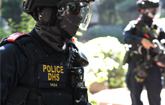Lockheed Martin, Raytheon Team to Provide SEWIP Electronic Attack Capability for U.S. Navy Anti-ship Missile Defense
WASHINGTON, Jan. 31, 2012 /PRNewswire/ -- Lockheed Martin (NYSE: LMT) and Raytheon Company (NYSE: RTN) are teaming to compete for a U.S. Navy contract that will upgrade the fleet's capability to electronically attack anti-ship missiles.
Through its Surface Electronic Warfare Improvement Program (SEWIP) Block 3 upgrade, the Navy seeks to cost effectively enhance the electronic attack (EA) capability of its AN/SLQ-32 V(3) and V(4) electronic warfare (EW) systems to counter threat technology advances. All U.S. aircraft carriers, cruisers, destroyers and other warships use the AN/SLQ-32 EW system.
SEWIP Block 3 is the latest upgrade in an evolutionary succession the Navy is pursuing for its EW system. Each upgrade incrementally adds new defensive technologies and functional capabilities. The Lockheed Martin-Raytheon team intends to offer a SEWIP Block 3 solution derived from more than 80 years of combined, proven experience in developing systems to defend the fleet. A formal Navy request for proposals is anticipated later this year.
Under a $167 million contract awarded by the Navy in November 2009, Lockheed Martin is developing SEWIP Block 2, which includes passive detection capabilities for advanced threats and establishes a framework to easily integrate future upgrades. The Navy approved the Block 2 solution during a Critical Design Review in February 2011, and two engineering development models are undergoing integration and testing at Lockheed Martin's new EW systems test facility in Syracuse, N.Y.
"Technology is rapidly advancing around the world and we understand the threats our Navy faces are not simplified by today's fiscal challenges," said Carl Bannar, vice president of Lockheed Martin's Integrated Warfare and Surveillance Systems business. "By teaming with Raytheon, the original developer of the legacy AN/SLQ-32 program, we will provide the Navy with a solution for SEWIP Block 3 that addresses today's and tomorrow's evolving threats."
Developed by Raytheon in the 1970s, the original AN/SLQ-32 systems employed passive radar technology for early warning, identification and tracking of enemy threats. Subsequent upgrades provided an additional active capability for simultaneous jamming of multiple threats.
"Lockheed Martin's experience on the current SEWIP Block 2 system combined with Raytheon's expertise in shipboard EW will give U.S. Navy fleet commanders a critical advantage on the seas," said Mark Kula, vice president, Tactical Airborne Systems, for Raytheon Space and Airborne Systems. "The Lockheed Martin-Raytheon partnership provides the low-cost, high-reliability solution the Navy needs to meet current and future sea-surface threat environment."
Headquartered in Bethesda, Md., Lockheed Martin is a global security company that employs about 123,000 people worldwide and is principally engaged in the research, design, development, manufacture, integration and sustainment of advanced technology systems, products and services. The Corporation's net sales for 2011 were $46.5 billion.
Raytheon Company, with 2011 sales of $25 billion, is a technology and innovation leader specializing in defense, homeland security and other government markets throughout the world. With a history of innovation spanning 90 years, Raytheon provides state-of-the-art electronics, mission systems integration and other capabilities in the areas of sensing; effects; and command, control, communications and intelligence systems, as well as a broad range of mission support services. With headquarters in Waltham, Mass., Raytheon employs 71,000 people worldwide.
For additional information, visit our websites:
http://www.lockheedmartin.com/ms2
SOURCE Lockheed Martin
WANT YOUR COMPANY'S NEWS FEATURED ON PRNEWSWIRE.COM?
Newsrooms &
Influencers
Digital Media
Outlets
Journalists
Opted In






Share this article